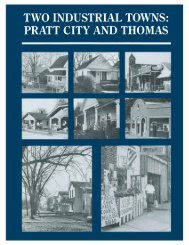The John Herbert Phillips High School Birmingham, Alabama
The John Herbert Phillips High School Birmingham, Alabama
The John Herbert Phillips High School Birmingham, Alabama
Create successful ePaper yourself
Turn your PDF publications into a flip-book with our unique Google optimized e-Paper software.
Office of Archaeological Research<br />
with galleries and a swimming pool, laboratories for general science and physics, armory and<br />
manual training shops, domestic science and art rooms, a library and study hall able to<br />
accommodate 500, hospital rooms, and a cafeteria able to accommodate 500. 20 By February 1922<br />
the foundations were complete and the contract for the superstructure was awarded to the<br />
Foundation Company, a general contracting company out of New York with both domestic and<br />
international offices. Total amount of the contract was $456,848. 21<br />
<strong>The</strong> dedication of <strong>Phillips</strong> <strong>High</strong> <strong>School</strong> on Memorial Day, 30 May 1923 was a celebrated<br />
event in <strong>Birmingham</strong>, consisting of all day festivities and ceremonies with music, presentation of<br />
the keys to the principal, and presentation of a portrait of Dr. <strong>Phillips</strong>. In the evening, remarks<br />
were made by Dr. George H. Denny of the University of <strong>Alabama</strong>, Dr. Spright Dowell of the<br />
<strong>Alabama</strong> Polytechnic Institute (Auburn), Dr. T.W. Palmer of the <strong>Alabama</strong> Technical Institute and<br />
College for Women, and Dr. H.J. Willingham of the Florence State Normal <strong>School</strong> (UNA).<br />
Finally, the dedicatory address was made by Dr. O.T. Corson of Oxford, Ohio, a close personal<br />
friend and colleague of Dr. <strong>Phillips</strong>. <strong>The</strong> new school served an area of twenty one square miles of<br />
the city of <strong>Birmingham</strong>, with Woodlawn handling students in the eastern end, and Ensley <strong>High</strong><br />
<strong>School</strong> handling western area students. Enrollment at the time of the opening of the first unit of<br />
the high school was 2,453 students. 22<br />
However, enrollment was increasing at a rate of twenty percent yearly, with an estimated<br />
3,000 students enrolling for the following year. By the summer of 1924 plans were underway to<br />
erect the second unit to the high school. In September of that year a contract for $347, 481 was<br />
awarded to O.D. Thomas and Son of Memphis, Tennessee. <strong>The</strong> second and final unit of <strong>Phillips</strong><br />
<strong>High</strong> <strong>School</strong> was completed in December 1925. 23<br />
Much of the layout of <strong>Phillips</strong> <strong>High</strong> <strong>School</strong>, designed by one of the state’s premier school<br />
architects, was also informed by the practice of William Ittner of St. Louis. Prior to his<br />
retirement from the St. Louis Board of Education in 1917, Ittner designed a number of school<br />
buildings for the city of St. Louis that received national acclaim for their functionality and utility.<br />
Following his retirement, Ittner became a consultant to a number of school boards, including<br />
<strong>Birmingham</strong>’s. He was a nationally recognized expert on the efficient design of school buildings.<br />
Some of the interior spatial arrangements may be a product of Ittner’s planned thinking.<br />
However, it should be remembered he was the consultant, not the designer.<br />
During the milieu in which <strong>Phillips</strong> <strong>High</strong> <strong>School</strong> was built, the Progressive movement in<br />
education was at its height. Progressive education had begun in the latter part of the Nineteenth<br />
century as a humanitarian effort to apply the promise of the American life as a response to the<br />
new urban based industrial world that was becoming widespread. Essentially, it was the<br />
educational aspect of American Progressivism. In the schools, it was viewed as a way of<br />
improving the lives of individuals. Educational Progressivism had several broad objectives, the<br />
first of which was broadening curricula and the function of schools in terms of health, vocation,<br />
and quality of life. Not only could the sciences be beneficial but so could the pursuit of the arts.<br />
<strong>John</strong> <strong>Herbert</strong> <strong>Phillips</strong> <strong>High</strong> <strong>School</strong> <strong>Birmingham</strong>, <strong>Alabama</strong><br />
12



